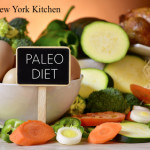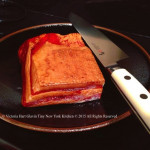French Toast Toppings
Ok, most of us love maple syrup on our pancakes and French toast, but sometimes it’s fun to change it up a bit. Here are some interesting alternatives that just may become your new favorites.
Apples & Thyme
Sauté 2 large Gala apples (cut into 1/2 inch thick pieces(, 1 tablespoon fresh thyme leaves and 1/4 teaspoon sugar in 2 tablespoons unsalted butter for 6 minutes until just tender.
Sweet & Spicy Bacon
Cook 1 pound bacon (cut into 1/2 inch pieces) in large-size skillet over a medium heat 10 minutes until nearly crisp. Using a slotted spoon transfer bacon to plate lined with paper towels. Wipe out skillet. Return bacon to skillet and cook 1 minute. Sprinkle with 1 tablespoon brown sugar and cook, tossing, until sugar melts. Drizzle with 2 tablespoons maple syrup and sprinkle with 1/8 teaspoon cayenne. Toss to coat.
Herbed Goat Cheese
In bowl combine 4 ounces goat cheese (at room temperature), 1 tablespoon chopped fresh tarragon and 1 tablespoon fresh parsley, 1 teaspoon lemon zest, and 1/4 teaspoon crushed red pepper flakes.
“Work With What You Got!”
© Victoria Hart Glavin Tiny New York Kitchen © 2016 All Rights Reserved
Pantry & Freezer Staples
How long do pantry and freezer staples last? Staple items are known for their long shelf life, but they don’t stay fresh forever! Use this handy list to determine how long you should keep them on hand.
Freezer
Hamburger & Stew Meats: Shelf Life: 1 to 2 Days Storage: 3 to 4 Months
Ground Turkey, Veal, Pork, Lamb: Shelf Life: 1 to 2 Days Storage: 3 to 4 Months
Bacon: Shelf Life: 7 Days Storage: 1 Month
Sausage (Raw From Pork, Beef, Chicken or Turkey): Shelf Life: 1 to 2 Days Storage: 1 to 2 Months
Fresh Steaks: Shelf Life: 3 to 5 Days Storage: 6 to 12 Months
Fresh Roasts: Shelf Life: 3 to 5 Days Storage: 4 to 12 Months
Chicken or Turkey (Whole): Shelf Life: 1 to 2 Days Storage: 1 Year
Chicken or Turkey (Cut Up): Shelf Life: 1 to 2 Days Storage: 9 Months
Lean Fish: Shelf Life: 1 to 2 Days Storage: 6 Months
Fatty Fish: Shelf Life: 1 to 2 Days Storage: 2 to 3 Months
Fresh Shrimp, Scallops, Crawfish, Squid: Shelf Life: 1 to 2 Days Storage 3 to 6 Months
Pantry
Baking Powder: Shelf Life: 18 Months Storage: Keep In Dry Place In Airtight Container
Beans (Dried & Uncooked): Shelf Life: 1 Year Storage: Store In Cool & Dry Place
Chocolate (Semisweet & Unsweetened): Shelf Life: 18 Months Storage: Keep In Cool Place
Cocoa: Shelf Life: 1 Year Storage: Keep In Cool Place
Cornstarch: Shelf Life: 18 Months Storage: Store In Airtight Container
Flour (White or Whole Wheat): Shelf Life: 6 to 8 Months Storage: Store In Airtight Container or Freeze To Extend Shelf Life
Nuts (In Shell & Unopened): Shelf Life: 4 Months Storage: Freeze to Extend Shelf Life
Spices & Herbs (Ground): Shelf Life: 6 Months Storage: Store in Airtight Containers In Dry Areas Away From Sunlight & Heat. Before Using, Check Aroma – If Faint Replace.
Sugar (Brown): Shelf Life: 4 Months Storage: Store in Airtight Container
Sugar (Confectioners’): Shelf Life: 18 Months Storage: Store in Airtight Container
Sugar (Granulated): Shelf Life: 2 Years Storage: Store in Airtight Container
Vinegar (Unopened): Shelf Life: 2 Years
“Work With What You Got!”
© Victoria Hart Glavin Tiny New York Kitchen © 2016 All Rights Reserved
Paleo Diet
The Paleo Diet (short for Paleolithic) is fashioned around the eating habits and available foods of our hunter-gatherer ancestors. These ancestors had to nourish themselves with the meat, fish, fruits, vegetables, nuts, and fats available to them in nature. With the benefit of large supermarkets, it’s easy today to mimic these foods in wider variety. Specific recommendations for eating Paleo will vary; however, the main ideas are the same: Reduce the risk of debilitating diseases and optimize health by eating whole, fresh, unprocessed foods and avoid foods that were not available prior to the advent of modern agriculture.
Research studies looking at the Paleo Diet have noted that eating a Paleo Diet for a short term improved the glucose control and lipid profiles in people with type 2 diabetes, compared to eating a diet containing low-fat dairy, moderate salt intake, whole grains, and legumes. Additional research indicates similar results may be possible in people without type 2 diabetes as well. The Paleo diet may result in higher levels of satiety (fullness) throughout the day when compared with a low-fat, low-calorie diet.
Paleo Do’s
Eat plenty of non-starchy vegetables and fruits.
Make fresh meat, poultry, fish, and seafood your primary sources calories.
Avoid highly processed meats that contain preservatives, artificial flavors, and sugar, such as some sausages, bacon, deli meats, and smoked fish products.
Consume nuts and seeds.
Use coconut oil, grass-fed butter, olive oil, avocado oil, nut and seed oils, and animal fats, such as goose fat or duck fat, for cooking and eating.
Balance the intake of acid-producing foods (meats, fish, salt, and cheese) with base-producing foods (fruits and vegetables) for optimal health.
Use sea salt to season foods, but try to decrease sodium intake in general.
Paleo Don’ts
Consume highly processed packaged foods.
Get heavy handed with the salt shaker.
Eat grains of any kinds. Quinoa, bulgur, rice, wheat, bread, pasta, etc., are all out.
Consume sugar (including honey and maple syrup), sweets, candy, or desserts.
Use artificial sweeteners, such as monk fruit extract, stevia, NutraSweet or Equal (aspartame), Splenda (sucralose), or sugar alcohols, such as xylitol, sorbitol, or maltitol.
Eat legumes, beans, peas, lentils, or soy, or foods make from soybeans.
Use canola or soybean oils or consume hydrogenated oils (trans fats).
Consume dairy, with the exception of fermented dairy or raw milk cheese on occasion.
“Work With What You Got!”
© Victoria Hart Glavin Tiny New York Kitchen © 2016 All Rights Reserved
Bacon & Bean Soup Is Done!
“Work With What You Got!”
© Victoria Hart Glavin Tiny New York Kitchen © 2015 All Rights Reserved
I picked up this beautiful piece of smoked bacon from New York City’s German specialty store, Schaller & Weber. I’m making a homemade bean and bacon soup and I’m absolutely delighted with this gorgeous piece of smoked bacon.
“Work With What You Got!”
© Victoria Hart Glavin Tiny New York Kitchen © 2015 All Rights Reserved
Here are some super easy, but versatile Pasta Salad Ideas from Tiny New York Kitchen. All you need to do is add 3 cups of cooked & chilled pasta (of your choice) and 1 tablespoon of extra virgin olive oil to one of these inspiring combinations. Try them all throughout the summer for a whole treasure trove of side salads. If you want to make any of these a main dish then add 1 pound of protein such as grilled chicken breasts, grilled flank steak, grilled shrimp, grilled tuna (or canned tuna) or tofu. All recipes below serve 4.
For the Pasta: Cook 3 Cups of Pasta, Toss With 1 Tablespoon Extra Virgin Olive Oil & Then Chill Until Ready To Use. Add the Pasta to One of the Salad Combinations Below.
Nutty Beans & Greens
1 Cup Trimmed & Steamed Haricot Verts
1 Cup Baby Arugula
3 Tablespoons Toasted & Chopped Walnuts
1 Ounce Shaved Parmigiano-Reggiano Cheese
Snow Peas & Carrots
1/2 Cup Grated Carrot
1 Tablespoon Soy Sauce
1/2 Cup Thinly Sliced Snow Peas
1/2 Cup Shredded Red Cabbage
1/4 Cup Dry Roasted Peanuts
Cheesy Chickpea & Pesto
1/2 Cup Cooked Chickpeas
1 1/2 Ounces Crumbled Feta Cheese
1 Cup Halved Grape Tomatoes
1 Tablespoon Prepared Pesto
Mediterranean Medley
1/3 Cup Chopped Fresh Basil
1/2 Cup Thinly Sliced Cucumber
1 Cup Halved Cherry Tomatoes
1 1/2 Ounces Crumbled Feta Cheese
1 1/2 Ounces Sliced Kalamata Olives
Peppery & Nutty
1 Cup Arugula
2/3 Cup Thinly Sliced Radishes
3 Tablespoons Toasted & Chopped Walnuts
2 Ounces Crumbled Goat Cheese
Melon, Mint & Parm
1/2 Cup Fresh Cubed Cantaloupe
2 Tablespoons Fresh Mint Leaves
2 Ounces Thinly Sliced Prosciutto
1 1/2 Ounces Shaved Parmigiano-Reggiano Cheese
Freshly Ground Pepper
Cherry Almond Crunch
3/4 Cup Pitted Halved Fresh Cherries
1/4 Cup Toasted & Thinly Sliced Almonds
2 Tablespoons Chopped Fresh Basil
1 1/2 Ounces Crumbled Goat Cheese
Picnic Superstar
1/3 Cup Sliced Avocado
1/4 Cup Red Bell Pepper Strips
1/4 Cup Fresh Corn Kernels
2 Cooked Crumbled Center Cut Bacon Slices
2 Ounces Quartered Fresh Baby Mozzarella Balls
Summer is here and why pay top dollar going out when you can make delicious hot dogs at home? Here is a guide to the different ways Americans make their frankfurters around the country. I had the Sonoran style hot dogs while I was in Tucson in February and absolutely loved them.
New York Style
Served with brown or German mustard and sauerkraut or onions cooked in tomato paste.
Chicago Style
Served on a poppy seed bun with mustard, pickle relish, sport peppers, onions, tomatoes, dill pickles and celery salt. Pepperoncini can be substituted for sport peppers.
Kansas City Style
Served on a sesame seed bun with brown or German mustard, sauerkraut and Swiss cheese.
Atlanta “Dragged Through The Garden” Style
Serve topped with coleslaw.
Detroit “Coney” Style
Served with chili, onions, mustard and cheddar cheese.
Seattle Style
Served with cream cheese and grilled onions.
Phoenix/Tucson “Sonoran” Style
Served as a bacon-wrapped hot dog with pinto beans, onions, tomatoes, mustard, mayo, jalapeno peppers and cheese.
Austin “Tex-Mex” Style
Served with queso, guacamole and crushed tortilla chips.
San Francisco “Wine Country” Style
Served with red wine caramelized onions and goat cheese.
Miami “Cuban” Style
Served with mustard, pickles and Swiss cheese.




















